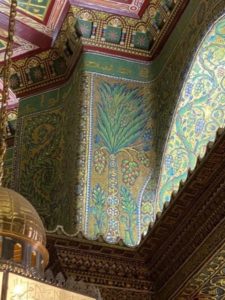Pilgrims to the Holy Land might be unaware of the fact that their devotion to the Virgin Mary is shared by numerous Muslims. Starting with the sacred book of Quran, many Islamic writings praise our Lady, presenting her as an example of virtues and obedience to God, and exalting her above all women.
Mary in the Quran
The Quran mentions several female figures in a positive way, including the wives of Muhammad the prophet. However, the only woman that is mentioned by her own name is Mary, the mother of Jesus. In the words of a Muslim scholar, “the Virgin Mary is the only woman who was privy to the revelation of Allah, and it is documented by the Koran that she talked to the Angel Gabriel. For these qualities, she is regarded as a very special woman in Islam […]. For Muslim women she is a role model” (A. Koçin, “Virgin Mary’s Importance in Islam and its Reflection on Classical Turkish Literature and Turkish Language”. Journal of History Culture and Art Research 6, 2017: 283).
Mary is mentioned 70 times in the 114 chapters or surahs of the Quran, and two surahs deal extensively with her figure. Surah 3, entitled “the family of Imran”, father of the Virgin, deals with her family and mentions her virginal conception of Jesus as a miracle of Allah. Surah 19, entitled “Maryam” or Mary, tells the story of the conception of our Lady and her infancy serving in the temple, and expands on the virginal conception of Jesus and the events that follow it. Mary is frequently mentioned with Jesus, who is called either by his name or by his title of Messiah, followed by the qualificative “son of Mary”.
An Islamic Representation of Mary in the Holy Land?
Some time ago, I was fortunate enough to visit the Dome of the Rock or Golden Dome in Jerusalem, the most important holy place for Islam after Mecca and Medina. Pointing at a beautiful representation of a palm tree in the old mosaic covering the external octagonal arcade of the building, our Muslim guide explained that it was nothing less than a symbol of the Virgin Mary. In the Muslim tradition derived from the Quran, our Lady would have given birth to Jesus under a palm tree, which miraculously fed her with its fruits. In fact, ancient Muslim writers mention the palm tree of Bethlehem and the pilgrims’ devotion towards it. Although the entrance to the Golden Dome is currently restricted to Muslims, Christian pilgrims might be pleased to learn that inside a place as central to Islam as this, there is such clear trace of veneration towards the mother of our Lord.
The Role of our Lady in the Story of Mohammed El-Attaz
The story of Mohammed el-Attaz, a 17th century Muslim prince converted to the Catholic faith in the Morrocan city of Fez, exemplifies the importance of this devotion to the Virgin Mary. In telling his life trajectory, which includes his calling to join the Company of Jesus, Baldasarre Loyola Mandes, as the prince was known after his conversion, mentions frequent apparitions of our Lady. In one of them our Lady would have appeared to him while he was washing the dishes in the Jesuit novitiate and, laughing, would have encouraged him, who had lived as a prince in his past life, with these words: “Wash Baldassare, wash, because I used to wash the dishes when I was in the world, and Jesus helped me.” (E. Colombo, “Muslim Turned Jesuit: Baldassarre Loyola Mandes (1631–1667)”, Journal of Early Modern History 17, 2013: 488).
By Irene Yung Park

The Palm tree photo by Irene Yung Park
